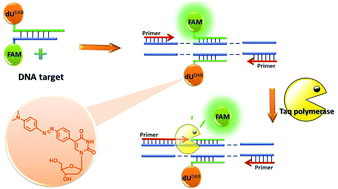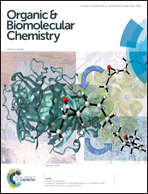Synthesis and evaluation of a photoresponsive quencher for fluorescent hybridization probes†
Abstract
Nowadays, most nucleic acid detections using fluorescent probes rely on quenching of fluorescence by energy transfer from one fluorophore to another or to a non-fluorescent molecule (quencher). The most widely used quencher in fluorescent probes is 4-((4-(dimethylamino)phenyl)azo)benzoic acid (DABCYL). We targeted a nucleoside-DABCYL analogue which could be incorporated anywhere in an oligonucleotide sequence and in any number, and used as a quencher in different hybridization sensitive probes. Specifically, we introduced a 5-(4-((dimethylamino)phenyl)azo)benzene)-2′-deoxy-uridine (dUDAB) quencher. The photoisomerization and dUDAB's ability to quench fluorescein emission have been investigated. We incorporated dUDAB into a series of oligonucleotide (ON) probes including strand displacement probes, labeled with both fluorescein (FAM) and dUDAB, and TaqMan probes bearing one or two dUDAB and a FAM fluorophore. We used these probes for the detection of a DNA target in real-time PCR (RT-PCR). All probes showed amplification of targeted DNA. A dUDAB modified TaqMan RT-PCR probe was more efficient as compared to a DABCYL bearing probe (93% vs. 87%, respectively). Furthermore, dUDAB had a stabilizing effect on the duplex, causing an increase in Tm up to 11 °C. In addition we showed the photoisomerisation of the azobenzene moiety of dUDAB and the dUDAB triply-labeled oligonucleotide upon irradiation. These findings suggest that dUDAB modified probes are promising probes for gene quantification in real-time PCR detection and as photoswitchable devices.


 Please wait while we load your content...
Please wait while we load your content...